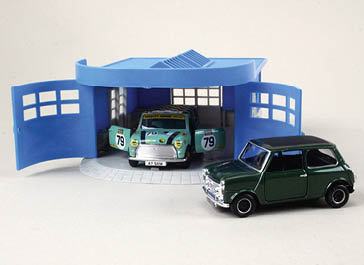20 February 2025
|
So, you’ve attended a swapmeet and were delighted to spot, tucked away at the back of a stand, a real rarity. The seller had it marked up in price, but not excessively so, and a deal was done. Back home, with your adrenaline slowed, you examine your prize more closely. Then you find something’s not quite right…
How to Spot Fake Diecast Models
The vintage United Kingdom toy industry is no different to any other collecting sector. As things become popular, there is a risk for fake models to be produced. Antiques, coins, banknotes, medals… you name it, they all attract the counterfeiters.

How Can Beginners Protect Themselves in the Toy Market?
When it comes to diecasts, there’s simply no substitute for experience. Get to as many toy fairs as you can and handle the merchandise.
That way, you’ll begin to learn something about matt paint finishes, wheel types, area of paint, amount of paint, where colour is added by hand and whether or not certain models were actually well made in the first place. Although even experienced collectors can get caught out, there’s no substitute for physical touching. Internet auction sites are all very well but it’s easy to conceal material facts in a photograph.
Suggested article: A Guide to Starting and Growing Your Diecast Car Collection
How Can Packaging Help Identify a Fake Diecast Model?
Faking can occur on several levels, so let’s begin with packaging. There are several sources of diecast replica boxes on the market and boxes for Corgi and Dinky model cars tend to be the most copied. Whilst laser printing and colour has progressed enormously, you have to work at ageing a box.
Very few toys of three or four decades ago will have a pristine box: the card goes soft, flaps get creased and general wear and tear are to be expected. Any mint box should be viewed with suspicion and, where possible, compared with something genuine. Colours are usually too ‘new’ or bright to deceive, the card is too crisp and the cellophane too clear.
Where window boxes are concerned, cellophane yellows with age and it’s rare to find shop-fresh packaging. Texture and feel are key here, so just be on your guard. The good news is that dealers with reproduction boxes will usually tell you they are such; it’s only when that same toy and box has passed through a few hands that the boundaries might start to blur.
How Can You Spot a Repainted Diecast Model?
On to paintwork – this is an area that calls for some deliberation, so always view a model in good light – at some meets, that’s a tough call! – and look not just for touching up (which is usually obvious) but also for areas of repainting. It’s rather like your local bodyshop: the painter will always spray a panel to hide a small mark, since it won’t stand out.
Why Are Rivets and Baseplates Important for Detecting Fakes?
Dinky and Corgi vehicles do turn up repainted, sometimes completely if the model is rare enough. If that’s the case, take a look at the baseplate to see if the rivets have been interfered with. It’s very hard to disguise rivet damage, which of necessity occurs when the baseplate is removed for a repaint.
Toy companies who made Dinky, Corgi and Spot-On were painted in ovens, with the paint baked on over primer and acid etching. Consequently, the paint is tough and tends to stay put. You can tap a Dinky car on the table and the paint won’t be affected.
A test for repaints is the trusty thumbnail: simply flick it quickly along a tiny area of gloss paint. Most repaints will shed a flake or two, which should give you cause for doubt. Moreover, matt finishes and paint age when exposed to ultraviolet light and the atmosphere and acquire what is termed a patina: it’s extremely hard to fake this.
How Do Fake Wheel Swaps Affect Matchbox Toys?
With Matchbox toys, the big money lies in the wheel varieties, leading the villainous to try and swap hubs and axles around to create a transitional model or similar. These have high margins when genuine, so all the faker needs is a model of each type. Good examples are the Regular Wheels to Superfast wheeled vehicles: switch the wheels on certain models and you have an item worth thousands of pounds.
However, to get the wheels off means filing the axle ends, which even when re-filed and shaped, will usually exhibit some marks or a less than perfect ‘mushroom’ end. Also, tiny rivets may have to be removed when the baseplate is changed: again, it’s hard to re-attach these without making some marks. Beware, then, of loose axles or wheels that are sloppy; and check the baseplate rivets, whilst determining if it wobbles a bit. A magnifying glass can help here.
Are Replacement Parts a Sign of a Fake Diecast Model?
Finally, look out for reproduction parts. There are many well-known purveyors of spares in plastic, resin, rubber and pewter, who cater for collectors of Tri-ang, Dinky, Spot-On and all the rest. Lost figures or missiles or attachments are par for the course with toys of some age but most can be replaced these days. A dealer should be able to advise you but it’s important to know if your Spot-On bumper, for instance, is original or after-market.
Finally, don’t run away with the impression that all traders are rogues, out to rob you: they’re not.
What Are the Best Tips for Avoiding Fake Diecast Models?
To sum up: handle with care, use common sense as much as you can and, if in doubt, ask!
UK Toy collectors can get the latest collecting news by signing up for the Collectors Club of Great Britain’s newsletter.







